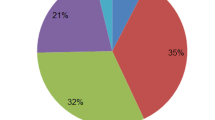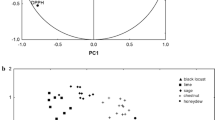Abstract
Chestnut, heather, honeydew, multifloral, orange blossom and thyme honey samples obtained either from beekeepers or supermarkets from Portugal, Greece, Oceania and Asia, were characterised by means of poly-parametric analysis: palynological, °Brix, moisture, pH, electrical conductivity, free acidity, total dissolved solids, salinity, vitamin C, specific weight, CIELAB colour parameters, Pfund and colour intensity determinations, along with bio-activity and volatile compounds analyses were carried out. Results showed that the botanical and geographical origin of honey samples had a similar impact on the determined parameters, using dimension reduction and classification techniques. Among them, moisture, °Brix, electrical conductivity, salinity, pH, colour parameters L* and b*, colour intensity, 1-hydroxy-2-propanone, benzaldehyde, 2-ethyl-1-hexanol, HMF and benzeneacetaldehyde were the potential markers related to the geographical and botanical origin of six honey varieties from different countries. Finally, the identification of methylglyoxal in Portuguese honeydew honey creates the basis for new research on the isolation and identification of this compound in European honey.






Similar content being viewed by others
References
EU Council Council Directive 2001/110/EC of 20 December 2001 relating to honey. Official Journal of the European Communities 2002, L10, 47–52
Von der Ohe W, Oddo PL, Piana ML, Morlot M, Martin P (2004) Harmonized methods of melissopalynology. Apidologie 35:S18–S25
Pita-Calvo C, Vázquez M (2018) Honeydew honeys: a review on the characterization and authentication of botanical and geographical origins. J Agric Food Chem 66(11):2523–2537
Piljac-Žegarac J, Stipčević T, Belšča A (2009) Antioxidant properties and phenolic content of different floral origin honeys. J ApiProduct ApiMed Sci 1(2):43–50
Alves A, Ramos A, Gonçalves MM, Bernardo M, Mendes B (2013) Antioxidant activity, quality parameters and mineral content of Portuguese monofloral honeys. J Food Compos Anal 30:130–138
Israili ZH (2014) Antimicrobial properties of honey. Am J Ther 21(4):304–323
Commission Implementing Regulation (EU) No 872/2012 of 1 October 2012 adopting the list of flavouring substances provided for by Regulation (EC) No 2232/96 of the European Parliament and of the Council, introducing it in Annex I to Regulation (EC) No 1334/2008 of the European Parliament and of the Council and repealing Commission Regulation (EC) No 1565/2000 and Commission Decision 1999/217/EC
Jánosková N, Vyviurska O, Spánik I (2014) Identification of volatile organic compounds in honeydew honeys using comprehensive gas chromatography. J Food Nutr Res 53(4):353–362
Ciappini M, Vitelleschi M, Calviño A (2016) Chemometrics classification of Argentine clover and eucalyptus honeys according to palynological, physicochemical, and sensory properties. Int J Food Proper 19(1):111–123
Karabagias IK, Nikolaou C, Karabagias VK (2019) Volatile fingerprints of common and rare honeys produced in Greece: in search of PHVMs with implementation of the honey code. Eur Food Res Technol 245(1):23–39
Karabagias IK, Maia M, Karabagias VK, Gatzias I, Badeka A (2018) Characterization of eucalyptus, chestnut and heather honeys from Portugal using multi-parameter analysis and chemo-calculus. Foods 7(12):194
Harmonised methods of the International Honey Commission (IHC, 2009) Responsible for the methods: Stefan Bogdanov, Bee Product Science. www.bee-hexagon.net
Karabagias IK, Dimitriou E, Kontakos S, Kontominas MG (2016) Phenolic profile, colour intensity, and radical scavenging activity of Greek unifloral honeys. Eur Food Res Technol 242(8):1201–1210
Ferreira ICFR, Aires E, Barreira JCM, Estevinho LM (2009) Antioxidant activity of Portuguese honey samples: different contributions of the entire honey and phenolic extract. Food Chem 114:1438–1443
Karabagias IKK (2019) Seeking of reliable markers related to Greek nectar honey geographical and botanical origin identification based on sugar profile by HPLC-RI and electro-chemical parameters using multivariate statistics. Eur Food Res Technol 245(4):805–816
Fawcett T (2006) An introduction to ROC analysis. Pattern Recognit Lett 27:861–874
Louveaux J, Maurizio A, Vorwohl G (1978) Methods of melissopalynology. Bee World 59:139–157
Yang Y, Battesti M-J, Djabou N, Muselli A, Paolini J, Tomi P, Costa J (2012) Melissopalynological origin determination and volatile composition analysis of Corsican “chestnut grove” honeys. Food Chem 132(4):2144–2154
Estevinho L, Pereira AP, Moreira L, Dias LG, Pereira E (2008) Antioxidant and antimicrobial effects of phenolic compounds extracts of Northeast Portugal honey. Food Chem Toxicol 46:3774–3779
Silva LR, Videira R, Monteiro AP, Valentão P, Andrade PB (2009) Honey from Luso region (Portugal): physicochemical characteristics and mineral contents. Microchem J 93(1):73–77
Feás X, Pires J, Estevinho ML, Iglesias A, De Araujo JPP (2010) Palynological and physicochemical data characterisation of honeys produced in the Entre-Douro e Minho region of Portugal. Int J Food Sci Technol 45:1255–1262
Estevinho LM, Feás X, Seijas JA, Vázquez-Tato MP (2012) Physicochemical and pollen analysis of local honeys from the Lima Valley (Portugal). Electron J Environ Agric Food Chem 11:214–221
Estevinho LM, Feás X, Seijas JA, Pilar Vázquez-Tato MP (2012) Organic honey from Trás-os-montes region (Portugal): chemical, palynological, microbiological and bioactive compounds characterization. Food Chem Toxicol 50:258–264
Pires J, Estevinho ML, Feás X, Cantalapiedra J, Iglesias A (2009) Pollen spectrum and physico-chemical attributes of heather (Erica sp.) honeys of North Portugal. J Sci Food Agric 89:1862–1870
Gomes S, Dias LG, Moreira LL, Rodrigues P, Estevinho L (2010) Physicochemical, microbiological and antimicrobial properties of commercial honeys from Portugal. Food Chem Toxicol 48:544–545
Karabagias IK, Louppis A, Kontakos S, Drouza C, Papastephanou C (2018) Characterization and botanical differentiation of monofloral and multifloral honeys produced in Cyprus, Greece and Egypt using physicochemical parameter analysis and mineral content, in conjunction with supervised statistical techniques. J Anal Methods Chem 2018:10
Soares S, Pinto D, Rodrigues F, Alves RC, Oliveira MBP (2017) Portuguese honeys from different geographical and botanical origins: a 4-year stability study regarding quality parameters and antioxidant activity. Molecules 22:1338
Mădas NM, Mărghitas LA, Dezmirean DS, Bonta V, Bobis O, Fauconnier M-L, Francis F, Haubruge E, Nguyen KB (2019) Volatile profile and physico-chemical analysis of acacia honey for geographical origin and nutritional value determination. Foods 8:445
White JW (1984) Instrumental color classification of honey: collaborative study. J AOAC 67:1129–1131
USDA Agricultural Marketing Service (1985) United States Standards for Grades of Extracted Honey. USDA, Washington DC
Aazza S, Lyoussi B, Antunes D, Miguel MG (2013) Physicochemical characterization and antioxidant activity of commercial Portuguese honeys. J Food Sci 78:C1159–C1165
Pontes M, Marques JC, Câmara JS (2007) Screening of volatile composition from Portuguese multifloral honeys using headspace solid-phase microextraction-gas chromatography-quadrupole mass spectrometry. Talanta 74:91–103
Miguel MG, Aazza S, Antunes MD, Faleiro ML, Barroso JG, Pedro LG, Figueiredo AC (2016) Mineral and volatile composition of água-mel from Portugal. Eur Food Res Technol 242:171–178
Tamura H, Appel M, Richling E, Schreier P (2005) Authenticity assessment of γ- and δ-decalactone from Prunus fruits by gas chromatography combustion/pyrolysis isotope ratio mass spectrometry (GC-C/P-IRMS). J Agric Food Chem 53(13):5397–5401
Castro-Vázquez L, Díaz-Maroto MC, Guchu E, Pérez-Coello MS (2006) Analysis of volatile compounds of eucalypt honey by solid phase extraction followed by gas chromatography coupled to mass spectrometry. Eur Food Res Technol 224(1):27–31
Surburg H, Panten J (2016) Common fragrance and flavor materials: preparation, properties and uses, 6th edn. Wiley-VCH Verlag GmbH & Co KGaA, Weinheim
Mavric E, Wittmann S, Barth G, Henle T (2008) Identification and quantification of methylglyoxal as the dominant antibacterial constituent of Manuka (Leptospermum scoparium) honeys from New Zealand. Mol Nutr Food Res 52(4):483–489
Author information
Authors and Affiliations
Corresponding author
Ethics declarations
Conflict of interest
The authors declare that they have no conflict of interest.
Research involving human participants and/or animals
This article does not contain any studies with human or animal subjects.
Informed consent
For this type of study, formal consent is not required.
Additional information
Publisher's Note
Springer Nature remains neutral with regard to jurisdictional claims in published maps and institutional affiliations.
Electronic supplementary material
Below is the link to the electronic supplementary material.
Rights and permissions
About this article
Cite this article
Karabagias, I.K., Maia, M., Karabagias, V.K. et al. Quality and origin characterisation of Portuguese, Greek, Oceanian, and Asian honey, based on poly-parametric analysis hand in hand with dimension reduction and classification techniques. Eur Food Res Technol 246, 987–1006 (2020). https://doi.org/10.1007/s00217-020-03461-8
Received:
Revised:
Accepted:
Published:
Issue Date:
DOI: https://doi.org/10.1007/s00217-020-03461-8




